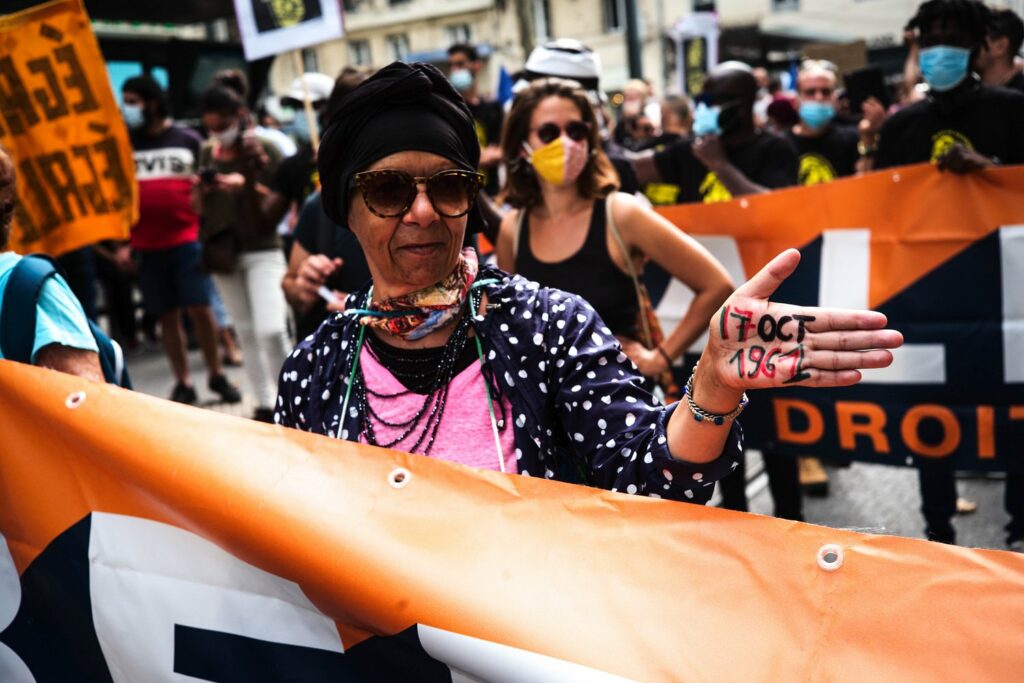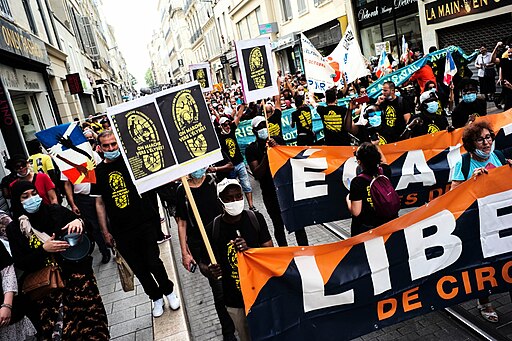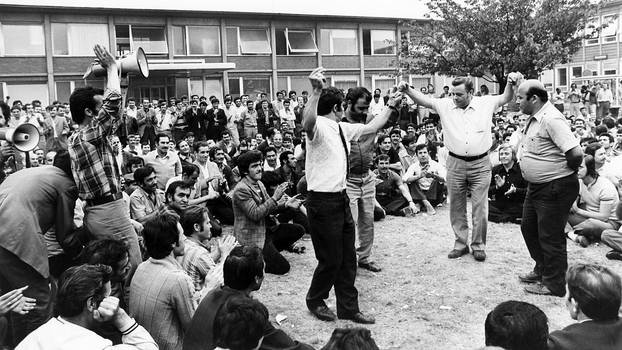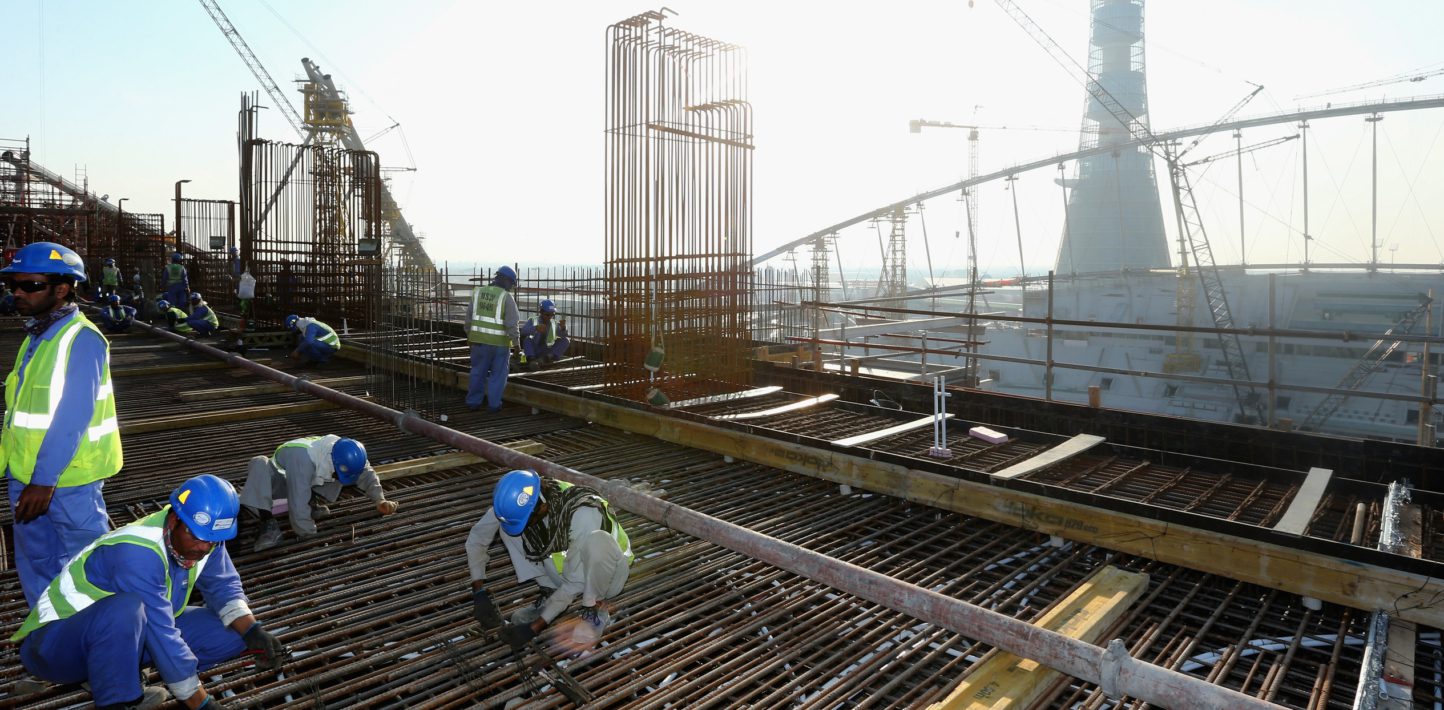
Note from LeftEast editors: This article is a slightly expanded and edited version of a text, which appeared first in Slovak in Kapital. We publish the English original with permission. The article appears within the framework of the East European Left Media Outlet (ELMO).
“For capitalism migrant workers fill a labour shortage in an especially convenient way. They accept the wages offered and, in doing so, slow down wage increases in general.” – John Berger, The seventh man: 1975: 251
“Aber die Hauptsache am Menschen sind seine Augen und seine Füße. Man muß die Welt sehen können und zu ihr hingehn1.” – Alfred Döblin, Berlin Alexanderplatz
Migrant workers embody multiple contradictions of social, political, and economic life that humanity faces in contemporary global hypermobile capitalism: they are structurally weak, occupy vulnerable and often outsourced positions under the controlling hands and influence of employers or more complex state structures. Both those employers and state structures tend or rather pretend to know, in a paternalistic fashion, the interests of workers better than these workers themselves. Employers offer them short-term financial rewards for hard work, and the fewer questions workers have, or problems they might raise beyond the wage question, the better. States, on both the sending and receiving ends of migrant labour, establish infrastructure that is more or less developed and more or less outsourced to private intermediating actors. These intermediary actors are less visible but extremely powerful. From the start, they financially capitalise on migrant workers by charging them obscene fees for “arranging them the proper paperwork” to go abroad, thus turning them into migrants.
In the quote above, John Berger reflects on the moment in which migrant workers are “instrumental” in maintaining a labour market and “running the show” but also key for a particular historical moment in which nation states regulated economies in conditions of labour shortages. Today, when labour shortages are back on an even greater global scale, we see a vicious cycle of extreme competition, rapid labour migration, promises of high gains, high risks, and rising social costs. Perhaps now the wage suppression Berger spoke of is less visible, but compared to the 1970s, today working conditions are deteriorating even more rapidly and with greater and deeper structural significance. In our “Modern Times,” deterioration of labour standards is pegged to an ongoing general deterioration of the meaning and political recognition of (wage) labour. New and ever more flexible forms of wage labour – such as temporary agency work combined with several layers of outsourcing and transnational posting – continue to appear and local workers are increasingly pushed out of certain sectors. All these trends remind us of the uneasy relationship between slave and ‘free’ wage labour as discussed by Engels. The fragmentation of employment is the new reality and therefore chances of forging collective identities and organising are increasingly difficult. Institutions governing labour markets are likely to be overburdened with work, operate with outdated legal tools, and in an increasing number cases don’t even dare to use the powers they do have, like the shutting down of companies that violate labour laws. Key labour market institutions need significantly more financial, technological and human resources, as well as expertise. It is a matter of political will, whether these institutions – trade unions and employer organisations included – will receive sufficient support to cope with new challenges and have better capacities to improve labour standards. Alternatively, non-governmental organisations are increasingly providing supporting services that are in the core competencies of welfare state institutions and labour institutions. The latter scenario then creates two imperfect actors, which work in the same area, but with different authorisation, capacities, and competencies. Rather than creating complementarities, here the ultimate effect is negative: a schizophrenic situation which is legitimising the weakening of relevant institutions.
l.
At the same time, migrant workers definitely aim ”to see the world and go after it”. Thus if we believe Alfred Döblin, they embody something most human: enjoying freedom, adventure, without restraint for gaining experience. But in the age of global capitalism this freedom is transformed into daily precarity and their humanity into commodified exploitation. As will be discussed, migrant workers’ existence is also related to their potential to organise and fight collectively, through strikes or other means.
Here we explore the obstacles to and the conditions of migrant worker collective action in the current global context of rapidly growing and expanding labour migration. First, we provide an overview of the potential of migrant labour organising, collective action and a brief catalogue of migrant workers’ self-organisation and collective action in the past few decades. Second, we zoom in on the experience of one regional initiative in Slovenia.
Migrant worker collective action: the conditions and dialectics of (self-)organisation and collective action
In the early 2000s, a wave of strikes by migrant workers in China exposed working conditions in the capital-intensive, foreign-owned industries of the Pearl River Delta, signalling a new era of workers’ struggle. Since then strike waves have continued to flare up in China’s manufacturing sector, which continues to rely on millions of migrant workers. These strikes demonstrate new forms of collective power and changing patterns of organising. Sociologist Chris King-chi Chan has argued that before the strikes, employer and state-driven power structures dominated not only the social relations of the workplace, officially installed trade unions but also of the communities where workers lived. Centrally important to labour organising, as Chan and his colleagues observed, was a historical point of time, a concrete event in which skill started to matter even in conditions of unlimited supply of migrant labour. The turning of the tides occurred when skilled workers’ autonomy came under management’s attack. Interestingly, and when locality, ethnicity, gender, age started to matter as constructive reference points for building working class solidarities. Still, in the absence of an independent union, collective action did not appear as part of formal trade union organising. Florian Buttolo and Tobias ten Brink argued that the strike wave was able to endure and appeared in various shapes precisely because of the Chinese government’s relatively permissive stance toward the movement and its tolerance for bottom-up wage pressure, but not for independent union movement and organisation, including autonomous collective bargaining. In other words, trade unions as a class organisation have been contested by a structurally more powerful actor: the state.
In other words, space had opened up for worker militancy but not for a stable, institutionalised social compromise. Migrant workers in China have been an active force seeking their own class organization that can represent the interests of workers in a relatively hostile setting, where class organization has been ineffective and freedom of association denied. Similar fragile temporary waves, or patterns of ‘wildcat’ strikes and collective actions of migrant workers – without stable organisational or institutional formations – can be observed also in settings such as among construction workers in Dubai or workers in foreign-owned manufacturing in Vietnam, where political authoritarianism, capital-labour fixes of high capital inflow meet with high migrant labour concentration.. In the Vietnamese case, the existence of a basic organisation of workers already created conditions for strike action, or made strikes easier to happen.
The question opens up, whether in more beneficial settings – with entrenched social labour market mechanisms and established collective bargaining structures – migrant workers can be organised, especially if they meet open trade unions? Or if, more generally, welfare state institutions governing labour markets are sensitive to new needs, and there are public investments in accommodating the most vulnerable? From an organisational point of view, especially if they had or received enough resources, some trade unions have been successfully experimenting with recruitment and general engagement with migrant workers at the community or labour market level, rather than at the workplace level (in the UK) or with mobilisation of migrant workers (in the Netherlands) but have not solved the issue of sustainable organisation of migrant workers. Finally, on the transnational level, there is mostly failure: transnational union efforts to organize migrant hyper-mobile workers collide with the logic of national protectionism, as many trade unions insist on developing solidarities on national level only, exclusively focusing on the defence of existing institutional arrangements. Here too, as the organisation of truckers has recently shown successes are possible but fragile.
In today’s EU, the employment of migrant workers is in many places associated with high levels of turnover and geographical mobility of labourers. According to a recent argument, such high mobility, and keeping labour markets in extreme flux is actually a new source of power for migrant workers. More cautiously, Alberti and Pero argue that migrant workers innovative and mobilisation potential have to be grounded in unique-own-formed organisation: “migrant workers can develop innovative collective initiatives located at the junction of class and ethnicity that can be effective and rewarding in material and nonmaterial terms bargaining and mobilisation strategies appear inadequate to accommodate the bottom-up initiatives.”

Migrant worker organising and identities are burdened with fundamental global but also gender inequalities and multiple power relations. Reproductive and household labour is a case in point: domestic labour is increasingly commodified in the rich North, and labour provided from the (semi)periphery or the Global South. In more regulated settings, as Rogalewski (2018) points out, migrant workers – caregivers from CEE can be the most militant and committed union members, bringing new life into existing – in this case Swiss – union organisations and structures. In less regulated settings, the struggle is more difficult, as struggles of domestic workers’ movements in the USA and India, or Latin America show. The struggle and collective actions of undocumented domestic workers is typically a long one, and fruits are ripening very slowly, as the French ‘sans-papier workers’ fight for legal status shows. Here, researchers observed an “agonistic coproduction by state policy and union strategy” in which the worker’s identity became an unsolved issue for both the state and the union. Neither actor could agree on when one started and stopped legally being a worker.
Migrant worker bottom-up initiatives often brought to the union various novel methods of strike or other forms of collective action. In the case of undocumented workers in France, at the peak of their protest wave, 7000 workers occupied enterprises, temporary work agencies and employer federations, while their counterparts in Belgium started a hunger strike. Besides direct action, migrant worker mobilisation and strike, as Oliveri suggests, might be a new source of power and paradigm model for citizen – activism adjusted to the era of global neoliberalism: the general strike of migrants, agricultural labourers in 2010-2011 Italy contested the exclusionary, racialized and competitive model and also brought to the frontline an alternative social model based on equal entitlements to rights, solidarity and real democracy. Such a conclusion is especially appalling as these migrant labourers were in an extremely vulnerable position: they were intentionally segregated and contracted via illegal hiring methods, and as noted above, their worker identity is not clear. We must not forget that recent direct action of migrant workers, such as occupying the premises of the enterprise of hunger strike, are fragile forms, showing only the potential of collective action compared to the classic highly organised trade union actions that proceed with high mobilisation such as strikes.
Migrant Workers in the EU labour market periphery
Migrant workers are increasingly present in the labour markets of Eastern European countries too, which simultaneously lose workers to higher-wage countries. In Slovenia, as in many other CEE countries, migrant workers are associated with labour shortages and an accelerating labour turnover. The speed of migration interacts with turnover and labour shortages and creates a new labour market reality. Migrant workers are typically income maximising. When contracting, they are guided by one question: how much can they earn. In doing so, they are also pushed from expectations in their home country to earn and send back the necessary money. In their income maximisation, they are also encouraged to take up opportunistic behaviour, and are willing to follow employers’ initiatives that go against established rules such as accepting illegal employment, shady practices or willingly undermining labour standards. Migrant workers also change jobs very quickly if they find that they do not earn enough. Employers quickly adapt, and are willing to change workers – because they think others will come. In some sectors, employers are increasingly tempted to employ below established labour standards or to violate regulation, and factor the penalties into their calculus. The ultimate effect is that there is a normalisation of illegal or at best questionable labour practices in many sectors: small violations are increasingly accepted and thus become new norms.
The migration infrastructure continues to develop at an amazing speed: transnational (out)sourcing, posting, and temporary agencies all flourish. So far, welfare state and labour market institutions in CEE have not been coping well with the new labour market reality: they are slow and operate with outdated infrastructure of repressive organisations, administration and bureaucracies, which receive little or no funding, and barely adjust to the new realities. In their inability to cope with the situation, they face the danger of irrelevance and atrophy. Trade unions also seem to react and innovate slowly. Unions tend to be conservative in their insistence on how the welfare state had been traditionally functioning, insisting also on a particular logic of union operation. Especially when faced with migrant workers and their problems, they are clinging to a conservative formalised organisational structure optimised for the old economic and institutional set-up, building on a stable product market, employment and labour market.
Examples from Slovenia
In Slovenia, too, even before the 2009 crisis, it was a matter of state priority for the economy that migrant workers come to work and fill shortages, but it was hardly a priority to inform and integrate the workers and their families. Trade unions and some civil society actors nevertheless recognised that providing information is a key step in the integration, which meant also an introduction to labour market institutions and main rules. Still, other critical questions were only sporadically tabled and discussed: how to finance migrant worker integration or, how to integrate special integration policies such as safe houses for the victims of labour exploitation into regular public policies?
In the last decade, projects were prepared to inform migrant workers, but these remained plans at the ministerial level, and the money went elsewhere, for example, into strengthening enforcement of labour legislation and other key institutions, including labour inspectorates. More than a decade ago, everyone was talking about migration, and the necessity of it. It was clear what are the directions and scope of changes, with all demographic trends and observable migration patterns. It is strange to see that today, welfare state institutions and labour market actors including trade unions insist that integration of migrant workers and their families is not really their business. The commitment of trade unions to migrant workers’ integration is still very low: they still do not organise migrant workers effectively.
The aim of establishing an organisation that specialises in providing information to migrant workers – the Counseling Office for Workers (Delavska Svetovalnica, DS) was to fill this vacuum. The Counseling Office was preceded by a project set up in 2010 within the framework of the largest Slovenian trade union confederation. That project focused on the “Integration of unemployed migrants.” After its completion in 2013, the team received funds from the Slovenian Employment Office to continue for another two years, after which neither the trade union nor the Ministry of Labor showed interest in funding the project further. In Slovenia the welfare state intentionally gave up on serving complicated outsiders – migrant worker clients – directly: in practical terms, it outsourced temporarily some of its key functions to civil society and union organisations. DS was preceded by a project set up in 2010 within the framework of the Association of Independent Trade Unions of Slovenia (ZSSS) focusing on the “Integration of unemployed migrants.” After its completion in 2013, the office received funds from the Slovenian Employment Office to continue for another two years, after which neither the ZSSS nor the Ministry of Labor showed interest in funding the project further. That is when the decision was to establish an association, the “Counseling Office for Migrants.” Altogether it was a fortunate set of resource circumstances: as we saw, it grew out of the union infrastructure, and could rely on its network. It was initially supported by the state. Later it was also based on recognition of the need and strong will of the personnel to proceed with direct work with migrants, irrespectively of insecure funding. Currently, it is a self-financing organisation, mostly from membership fees from migrant workers.
In most cases, the Office works with migrants employed in precarious arrangements. In the case of subcontracted workers of the public limited company operating the Port of Koper, it took the office almost a year to gain trust among a wider circle of workers, and an additional year to grow from meetings with a dozen to several tens and hundreds of workers, some of whom became members of the Office. Despite working in the Port of Koper for more than 10 years, migrant workers, mostly coming from various former Yugoslav republics in the 1990s, were literally hiding in plain sight in the town of Koper, trusting no one. They were performing various physically intensive jobs, spatially scattered across 4 large terminals. All of them were working for the main company through outsourced companies, and they learnt about their daily tasks the day before. At the peak, more than 20 companies were employing almost 1000 workers. These companies defined themselves as temporary service providers, but not as temporary work agencies because that would imply that the collective agreement of the Port of Koper would cover them too. Workers worked under not only a flexible but also intensive working schedule of more than 300 hours monthly, month by month, year by year. The implication was that these workers were living and working in an imposed ghetto, as second-class citizens-workers: they did not appear in public spaces.
As they were not employed on equal terms with those directly employed in the Port of Koper and treated as peripheral, lower-value workers for decades, also by core employees, it created a huge distrust among migrant workers towards others. For the Office, it took several months to break this distrust by identifying and meeting with a “core group” every week. Later, at the weekly meeting more than 80 workers were present, but a very strong connection and communication was maintained with all workers. Supported by workers, Delavka gained momentum to make the case public and raise awareness: the story became a major scandal and featured in the media for months. This created conditions to put the issue of their working conditions on the table of the lead employer – Port of Luka Koper. The agreement was made to employ more than 300 of these workers directly, but not all. Currently, there is an appeal to pay compensations for working as underpaid subcontracted employees: the case is still going through a long court process.
Organising migrant workers is a difficult, labour-intensive and risky enterprise, a case that classic trade unions would rarely take up because of these reasons. Time, resources and engagement are needed over longer periods of time, as this organising has to break distrust, deal with fragmentation, visible and invisible power relations and inequalities. Learning basic organisational patterns, such as to keep meeting at an exact time and place every week was key to accommodate social outsiders and also a condition to recognise an organisation as theirs. In this way, collegial relationships could develop, breaking down barriers between worker-members and external organisers.
Goran Lukic is among the founders of the Counselling Office for Workers, a non-governmental organisation which has directly advocated for workers and their rights for more than eight years, by phone, through social media, mail and in person in their office in Ljubljana.
Tibor T. Meszmann is a researcher at the Central European Labor Studies Institute, Bratislava, alumni member of Public Sociology Working Group “Helyzet”, Budapest, and editorial board member of LeftEast. His research is at the border of the interdisciplinary areas of industrial relations and sociology of work. Tibor’s work covers trade union politics, the world of labor in automotives, and more recently, platform mediated work, especially in Hungary, but also in Serbia: Labour migration is an increasingly common theme to these areas of inquiry.
- But the main things about people are their eyes and their feet. They should be able to see the world and go after it.
 Striking Turkish workers at the Ford factory in Cologne-Niehl, 29 August 1973. The wildcat strike was triggered by the firing of 300 workers who returned home from vacation behind schedule, but in reality, it was about a lot more than that.
Striking Turkish workers at the Ford factory in Cologne-Niehl, 29 August 1973. The wildcat strike was triggered by the firing of 300 workers who returned home from vacation behind schedule, but in reality, it was about a lot more than that.

